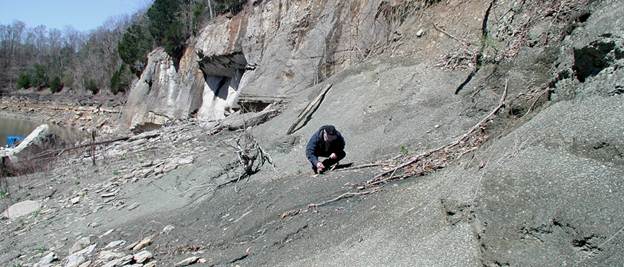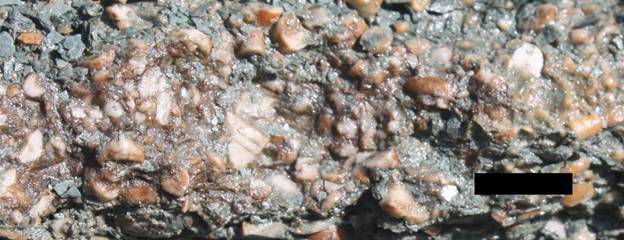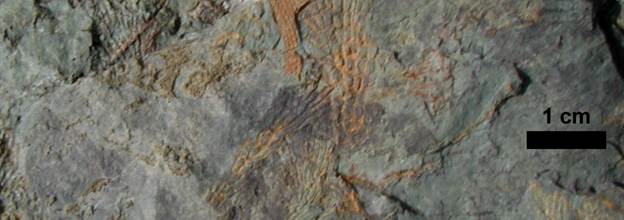

KGS Home > Geology of Kentucky
Green Fossiliferous Core Shale
Green, silty, glauconitic and fossiliferous shale occurs at the core of all Fort Payne buildups (Fig. 1). Krause and Meyer (2004) combined green shales within mounds with green-gray shales above the mounds into the same facies, but herein the shales are subdivided as a separate facies similar to (but slightly different from) the green shale facies of Knox and Stapor (2003). Core shales may be relatively flat bedded to tabular, or bedding may be slightly concave-upward, producing a mound shape (Fig. 2). Bedding in the core shale is generally not symmetrical with the mound shape of the facies as a whole. Usually, bedding within the facies (where visible) shows a basal upbuilding or concavity toward one side of the mound and then lateral offlap, or slight discontinuities in overlying beds within the facies. Core shales weather rapidly, which can make bedding difficult to determine in older or wave-washed exposures (Fig. 1).

Figure 1. Typical appearance of weathered, green fossiliferous core shale
at the base of Fort Payne buildups. Dave Meyer for scale.

Figure 2. Margin of green core shale at the base of a Fort Payne buildup.
Concavity of the facies as a whole is defined by sharp contact with overlying carbonates.
Also, apparent concavity and bedding within the shale, as well as a small fault are present.
Frank Ettensohn for scale.
Knox and Stapor (2003) divided Fort Payne buildup core shales into two facies: a green shale and a heterolithic green shale with interbedded limestone. Many core shales contain thin limestone (wackestone) layers. Herein, those thin beds are included in the green core shale facies, but in some buildups where such interbeds are abundant it might make sense to separate out a heterolithic shale facies. Where thin limestones occur in the core shales they accentuate the attitude (dip) of bedding within the shale. Generally, interbedded limestones are sharp-based, thicken downdip, and are composed of coarse crinoidal debris (Fig. 3).

Figure 3. Coarse crinoidal debris in thin (1.5 cm) limestone bed
within the green fossiliferous core shale facies. Black bar = 1 cm.
The basal contact of the green fossiliferous core shale facies is sharp where exposed. In Tennessee, the core shale directly overlies the clayey, glauconitic Maury Shale (Knox and Stapor, 2003). In Kentucky, the core shale may directly overlie or be slightly above the Maury-equivalent in the lower Fort Payne Formation (see for example, Lewis and Potter, 1978). The Maury is not formally recognized as a stratigraphic unit in Kentucky, but does occur at the base of the Fort Payne Formation in many areas. The base of the Fort Payne buildups is not well exposed in most areas. In contrast, the upper contact of the core shale is exposed in many areas, and is always sharp with overlying facies. The upper contact surface may define the mound shape of the buildups. Green core shales are generally overlain by shaly packstone or massive wackestone facies.
Fenestrate bryozoans are the dominant fossil debris in the green fossiliferous core shale facies (Fig. 4), but crinoid debris is also very common (Fig. 5). Robust crinoid columnals may be more visible than fine fenestrate fronds, even though frond fragments are abundant. Lists of fossils in the green shale are provided in Krause and Meyer (2004), Meyer and Ausich (1992), and Knox and Stapor (2003).

Figure 4. Fenestrate bryozoan frond in green core shale.

Figure 5. Crinoid columnals in green core shale.
Knox and Stapor (2003) considered the core shale to be the main upward-building part of the buildups. In contrast, other reports have considered the overlying massive wackstone facies to be the main growth component of the mounds (Ausich and Meyer, 1990; Krause and Meyer, 2004). Most researchers recognize that fenestrate bryozoans in the core shale likely trapped suspended clastic sediments, which initiated local mounding (see for example, Lewis and Potter, 1978). Fallen fronds may also have helped to stabilize core shale sediments (Knox and Stapor, 2003). There are differences of opinion as to whether the sharp contact of the core shale with overlying facies indicates a change in deposition with overlying carbonates draping the mounded core shales, or whether the core shales were eroded into an erosional remnant that was draped by the carbonates.
Back to Typical Facies of Fort Payne Buildups
Back to top of Geology of the Fort Payne Formation